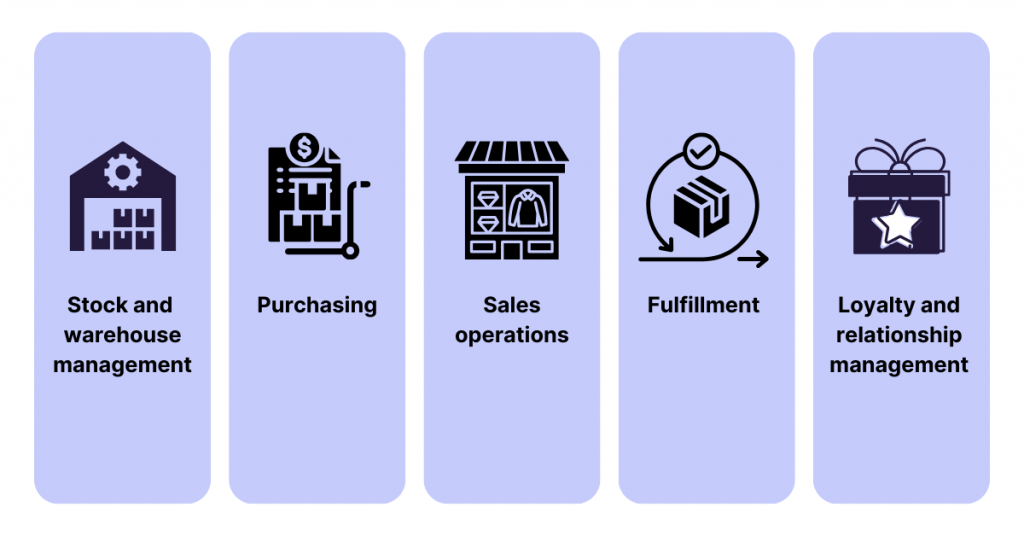This is the fifth installment of our Unified Commerce series, and we continue to explore the world of unified commerce and how Magento (Adobe Commerce) enables businesses in this realm. If you haven’t already, make sure to read the fourth article in the series.
In this article, we’ll discuss the critical aspects of centralizing data in the context of unified commerce, exploring why it’s essential and what key data points need to be integrated across different phases of the supply chain to enhance customer experiences and operational efficiency.
The crucial role of data synchronization

Importance of consistent customer experiences
Imagine this: A customer browses your online store and adds a product to their cart, but when they switch to your mobile app, the item has mysteriously disappeared. Frustrating for the customer, isn’t it?
This scenario underscores the significance of data synchronization. Keeping data consistent across all sales channels ensures that customers encounter a seamless and uniform shopping journey, regardless of the entry point.
Real-time data synchronization for accuracy
In the fast-paced world of eCommerce, information becomes outdated in the blink of an eye. Real-time data synchronization is the antidote to this challenge. With synchronized data, inventory levels, pricing, product descriptions, and other critical information remain not just accurate but up-to-the-minute. This precision eliminates costly errors, such as overselling products, and minimizes customer disappointment—a vital aspect of customer experience.
Challenges of data inconsistency
Failure to maintain data consistency across sales channels can lead to a slew of problems. It hinders effective decision-making, disrupts inventory management, and causes confusion among your customers. To avoid these pitfalls, a strategic approach is essential: centralized data management.
Centralized data management system
What is data centralization in Magento?
Adopting a unified commerce strategy has become imperative amidst a competitive eCommerce environment. This strategy involves establishing seamless communication channels across various platforms, including physical stores, online platforms, mobile devices, and social media, ensuring a consistent brand experience.
To effectively implement unified commerce initiatives and engage with customers individually, retailers must integrate multiple systems and databases. This integration encompasses Magento eCommerce platforms, Magento-integrated point-of-sale (POS) systems, ERP systems, customer relationship management tools, and marketing automation management tools, among others. The key to success in this unified commerce landscape is the creation of a fully integrated solution, often referred to as a centralized data management system.
With centralized data management in Magento, data remains consistently up-to-date and readily accessible to retailers. This accessibility empowers users to update crucial information vital to both the company and its customers, fostering efficiency and accuracy.
On the flip side, decentralized systems come with inherent disadvantages, notably data silos that hinder collaboration and decision-making. Breaking down these silos and establishing connections at the data layer is a crucial step toward effective unified commerce, amplifying the role of data in shaping decisions.
Benefits of a centralized system
Centralization is the keystone of data management success in unified commerce. It provides a single point of control, ensuring that every piece of data is uniform and synchronized across all channels. This not only simplifies your operational landscape but also fortifies your ability to deliver exceptional customer experiences.
Ensuring accuracy in critical data
Imagine you have multiple sales channels, each with its own pricing structure, and an eager customer spots an item on sale on one channel but not another. This inconsistency can erode trust and credibility. A centralized system ensures that inventory, pricing, product descriptions, and other critical data are consistent and up-to-date everywhere, leaving no room for such discrepancies.
Streamlining operations through data synchronization
Centralized data management not only maintains consistency but also streamlines operations. It simplifies the process of updating product information, tracking sales, and managing inventory levels. With data synchronized across all channels in real time, your business can operate efficiently and effectively, saving both time and resources.
In the next section, we’ll delve into how integrating your sales channels with Magento (Adobe Commerce) can be the catalyst for achieving these data management and synchronization goals.
Data centralization in Magento (Adobe Commerce)

In this section, we’ll outline the essential data that must be collected and centralized to facilitate a unified commerce system. We’ll also provide insights into the capabilities and limitations of using Magento (Adobe Commerce) for this purpose, providing clarity on what can be achieved and what might require additional considerations or solutions.
1. Stock and warehouse management
Centralized stock and warehouse management is pivotal for successful unified commerce operations. By managing all inventory from a single viewpoint across multiple sales channels, businesses can make customers happier through enhanced inventory visibility, increase ROI by optimizing inventory utilization, and simplify retail operations as the business scales.
Key data for tracking and centralization include warehouse details, product information, quantity of products in stock, etc.
- Magento (Adobe Commerce) supports Multiple Source Inventory (MSI), which centralizes inventory management across various sources and locations, streamlining tasks like inventory tracking, allocation rules, and source management.
- Integration with Amazon is also supported via a free Magento extension. The extension facilitates the synchronization of your product catalog from Magento to your Amazon selling account, allowing for centralized management and visibility of product types and information across your Magento websites and the Amazon Marketplace.
With MSI, you can connect to the POS in your offline stores. And a simple extension, you can synchronize your Magento and Amazon accounts. However, this is not yet a complete system. Unified commerce entails more data integration and visibility.
2. Purchasing
Purchasing or procurement entails obtaining the necessary goods and services vital for your company’s operational model. Unified commerce requires fully integrated purchasing operations, connecting them with inventory, sales, and fulfillment processes. This integration ensures that data generated during the procurement process becomes a valuable input for various interconnected activities.
Key data in this flow comprise product information, supplier information, price lists, purchase orders, receipts, and payable accounts. However, Magento (Adobe Commerce), on its own, doesn’t support full integration of the purchasing process. You’ll need to look for third-party solutions to fill this gap.
3. Sales operations
Unified commerce aims to provide shoppers with a seamless buying experience across all channels, from physical stores to online platforms. This approach also ensures that customers’ purchasing history is consistently updated with the right data.
In this context, key data for centralization include product details, prices, product attributes, online and offline sales orders, invoices, and shipment information.
- Magento (Adobe Commerce) supports multiple store views, supporting different languages and currencies, which retailers use to cater to various markets and geographies.
- The Amazon Sales Channel extension for Magento (Adobe Commerce) provides a convenient and user-friendly direct connection to Amazon’s U.S., Canada, Mexico, and UK marketplaces, allowing merchants to effortlessly tap into a vast customer base. Merchants can oversee their Amazon sales directly within the Magento admin page and maintain uniform product listings by managing their Magento catalog.
4. Fulfillment
Unified order fulfillment involves efficiently and seamlessly fulfilling orders across all channels and touchpoints through an integrated approach. It entails integrating various systems and procedures, such as inventory management, order processing, and shipping.
The integration centralizes all the operations relevant to order fulfillment, granting businesses real-time visibility into inventory levels and order statuses. It also allows them to select the most suitable source for order fulfillment based on factors like customer location and inventory levels.
Managing this process efficiently depends on centralizing key data such as product details, fulfillment status, distance, delivery time, picking and packing data, and shipping information.
- Magento supports these shipping options out of the box: in-store pickup, ship from store, real-time carrier rates, flat rates, free shipping
- While “buy in-store, home delivery” is not natively supported, merchants can use Magento’s built-in inventory management, order management, and shipping options to provide such a service.
- With third-party integrations and extensions, more fulfillment options can be added, such as dropshipping and “return anywhere.”
5. Loyalty and relationship management
Consistency is key in unified commerce loyalty programs. And achieving it requires centralizing customer profile data and loyalty records while synchronizing them across all sales channels. The result is more efficient customer interactions and enhanced customer engagement.
Key data to centralize here include customer information, reward points, product reviews, shared information, purchase history, amount paid, transactions, and discounts.
Centralized and synchronized customer and loyalty data facilitate personalized recommendations, streamlined purchasing, and accessibility across various devices, contributing to a seamless shopping experience. Retailers should remain agile, ready to adapt and innovate these programs regularly.
- Magento effectively synchronizes customer reward histories across various online channels.
- There is native support for customer management and discount/promotion features across multiple websites.
- Merchants can create additional customer profile attributes within Magento, enhancing personalization of offers and discounts.
However, there are certain advanced reward programs that Magento does not offer, including reward points, store credits, membership programs, and gift cards. Consequently, it faces limitations in storing and analyzing data related to customer behaviors and reward histories.
Also read:
Top Customer Loyalty Trends in 2023
Your Guide to Setting Up Loyalty Programs That Work
20 Great Customer Loyalty Program Examples by Industry
Comprehensive view for efficient management
The benefits of this consolidated data view extend across your entire organization. Whether you’re managing customer relationships, overseeing accounting and purchasing, or orchestrating marketing campaigns, having all your data synchronized and updated in real time streamlines these processes.
Streamlining customer management, accounting, purchasing, and marketing
The implications of this integrated data go beyond operational efficiency. They affect every facet of your business, ultimately enhancing your customer service. You can provide customers with real-time updates on their orders, delivery schedules, and other vital information, setting the stage for elevated customer satisfaction and loyalty.
Real-time data updates
The power of informed decision-making
Real-time data updates put this power squarely in your hands. Whether you’re adjusting pricing, restocking popular products, or launching marketing campaigns, having access to up-to-the-minute data ensures that your actions are timely and based on the latest market trends.
Agility in responding to changes in the market
Market dynamics change swiftly. Consumer preferences evolve, and external factors can influence demand. Real-time data updates enable your business to pivot and adapt quickly. If a product suddenly gains popularity, you can adjust your inventory and marketing strategies accordingly. This agility is a key factor in staying competitive and responsive to market shifts.
Enhancing customer service through up-to-date information
Perhaps most importantly, real-time data updates empower your customer service efforts. When customers reach out for information on their orders, having access to the latest data allows you to provide accurate and timely responses. This not only instills confidence in your brand but also helps reduce customer inquiries and complaints.
Conclusion
In the complex and dynamic world of eCommerce, data management and integration have emerged as the linchpin of success. Achieving sales channel efficiency demands that you keep data synchronized and accurate, providing customers with the consistent and personalized experiences they crave. Integration with Magento (Adobe Commerce) offers a path to consolidating your data, providing real-time updates, and ultimately enhancing customer service. It’s a strategy that not only streamlines your operations but also positions your business for sustained growth in an ever-changing marketplace.
So, why wait? Embrace data management and integration with Magento, and unlock the full potential of your eCommerce journey. Your customers will thank you, and your bottom line will too. Reach out for a free consultation.
The Unified Commerce series
- Part 1: Embracing Unified Commerce with Magento (Adobe Commerce)
- Part 2: Unified Commerce with Magento (Adobe Commerce): Best Practices and Case Studies
- Part 3: Integrating Your Sales Channels with Magento (Adobe Commerce)
- Part 4: Enabling Personalization in a Unified Commerce Strategy with Magento (Adobe Commerce)
- Part 5: Data Centralization: Unlocking Unified Commerce Success with Magento
Related articles
- Unified Commerce on Magento: Connecting the Physical and Digital Spheres of Retail
- eCommerce Report: UK Retailer Experience with Adobe Commerce
- PIM & eCommerce Integration: What You Need to Know
- Case Study: Seamless Synchronization and Custom Solutions with Akeneo PIM
- Case Study: Unifying Product Information with Pimcore PIM



Share on: